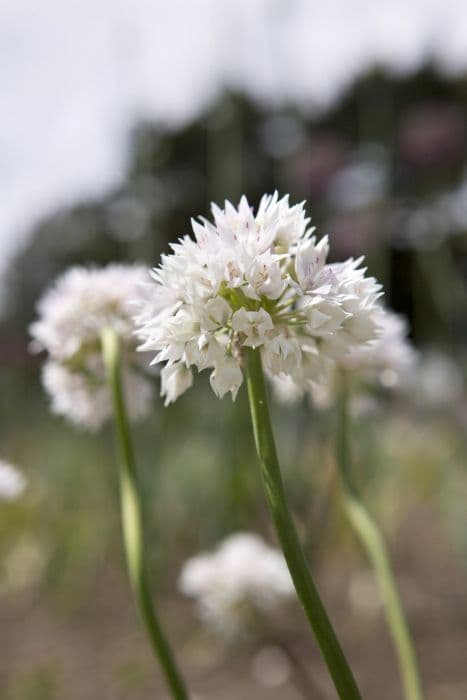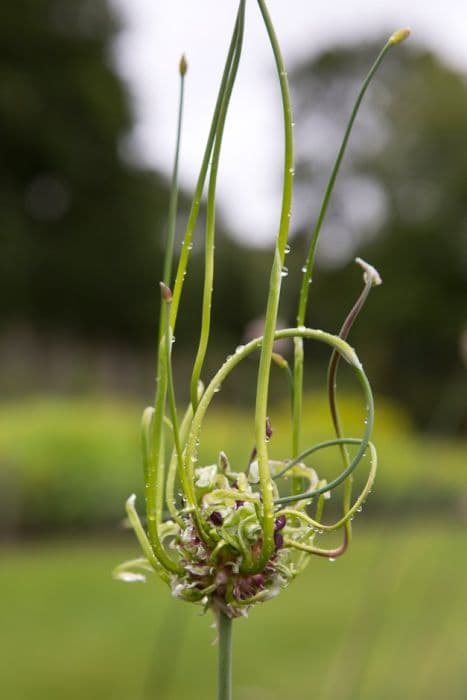Schubert's allium Allium schubertii
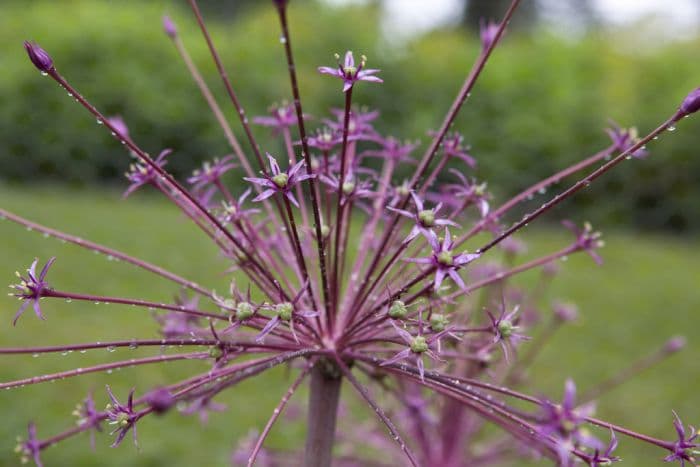

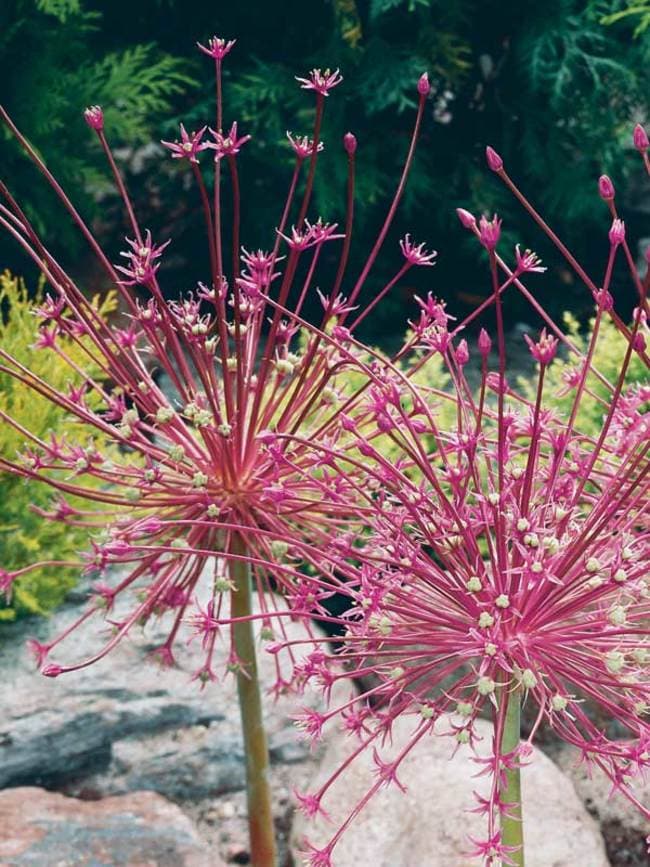
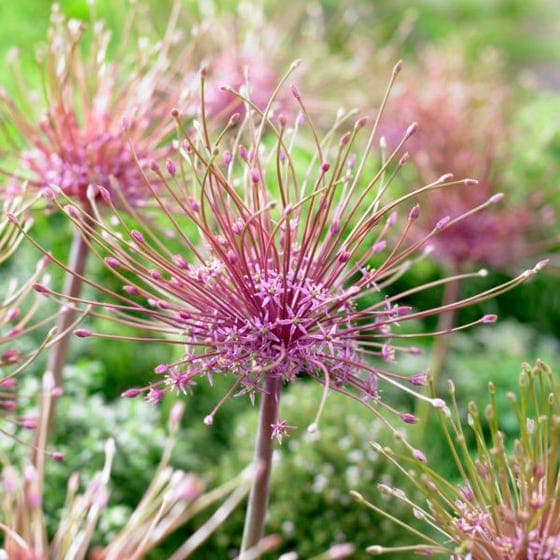
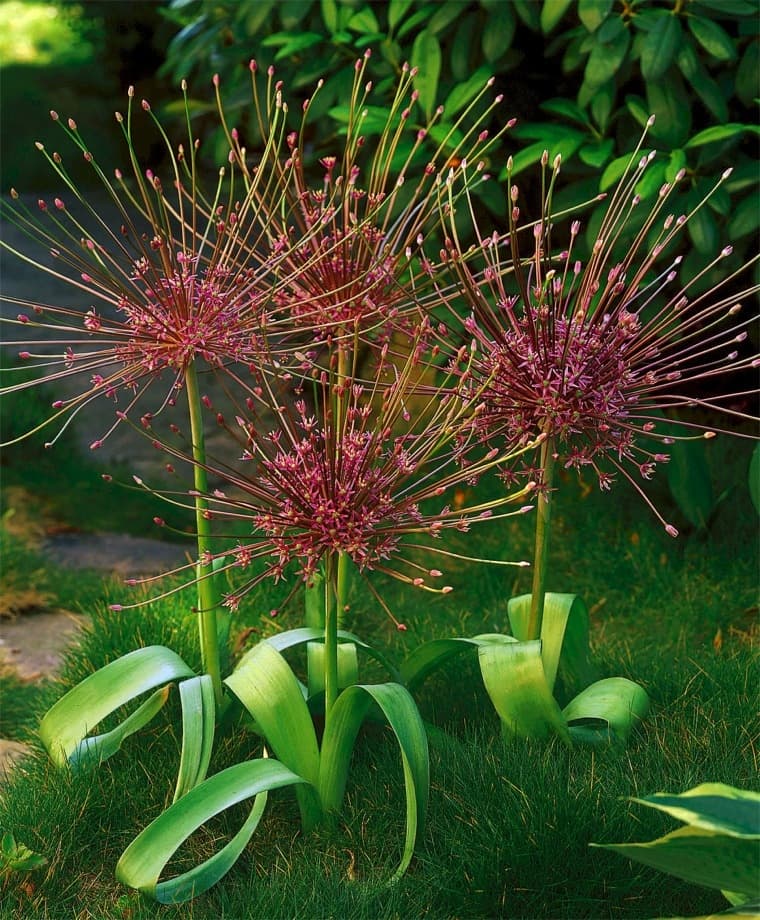
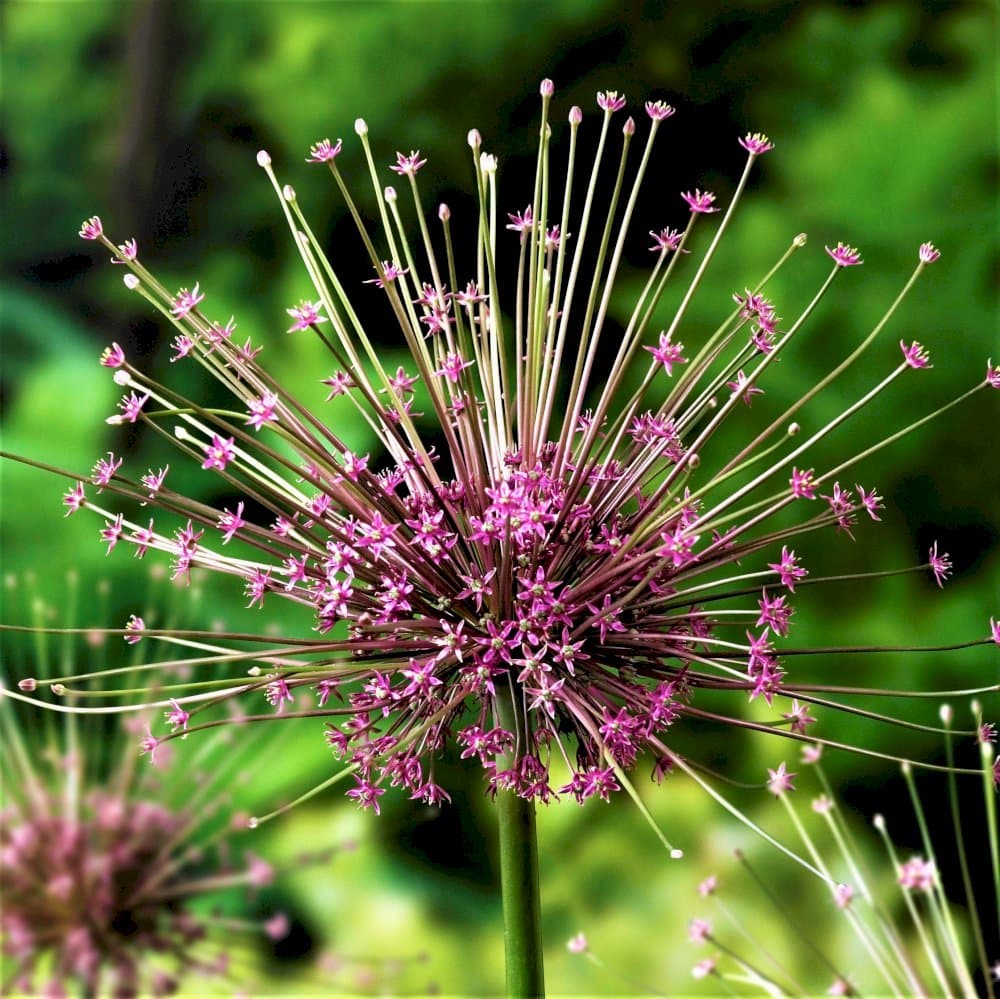
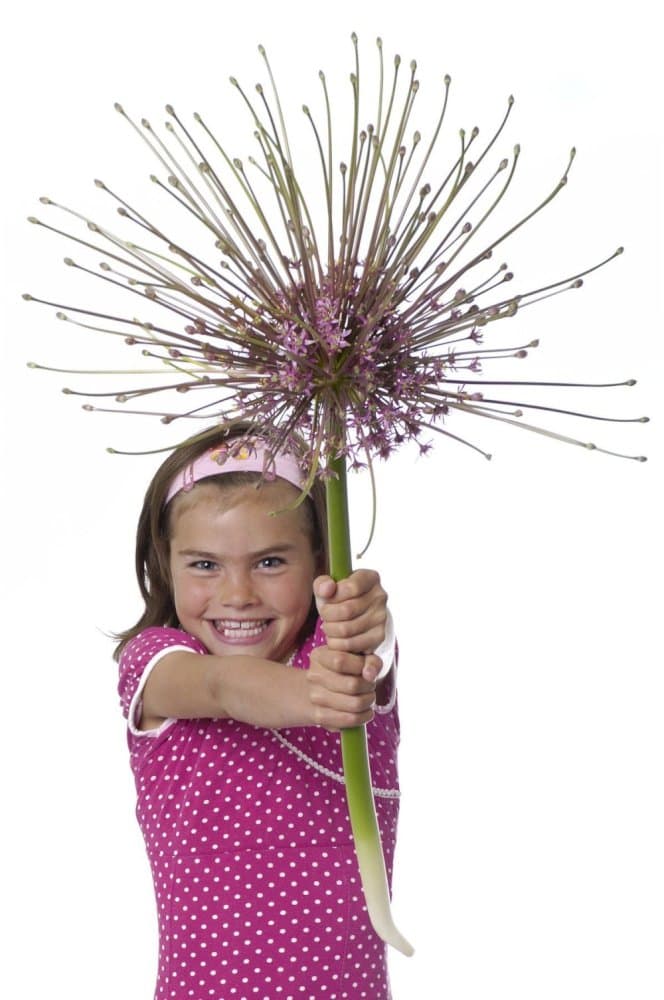
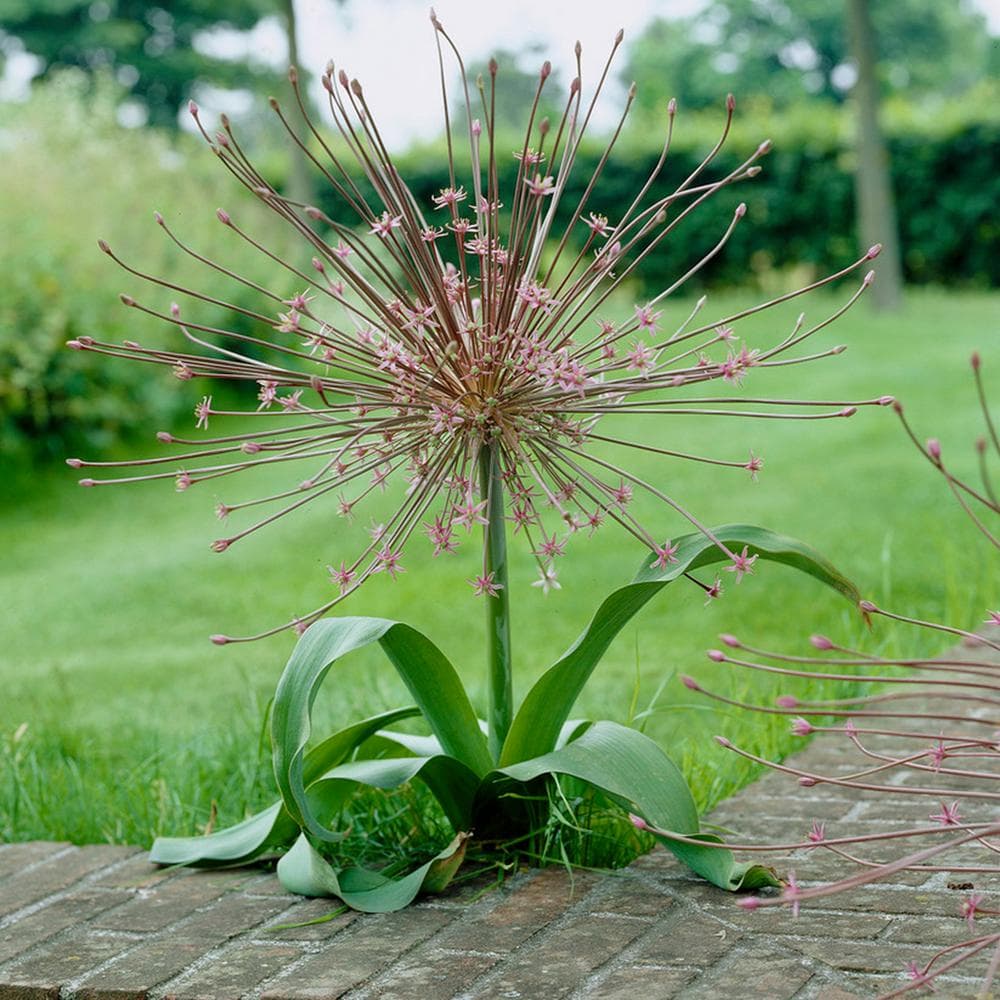
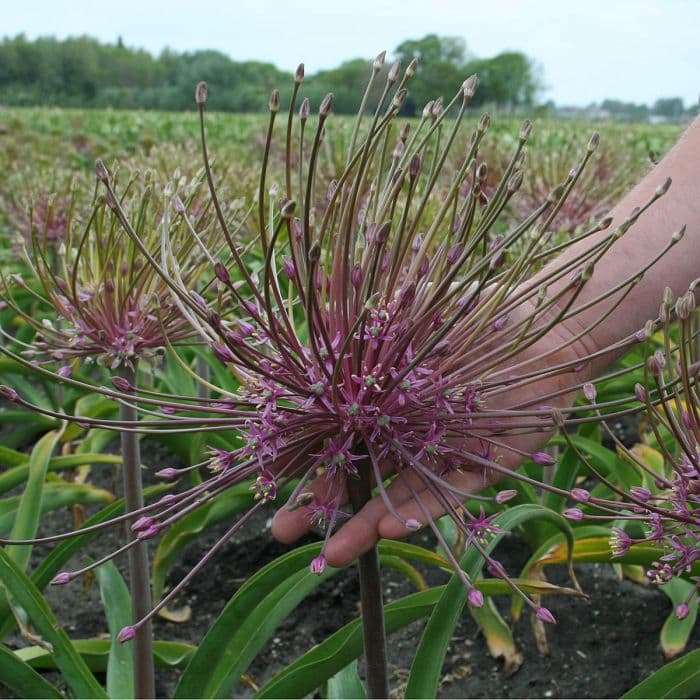
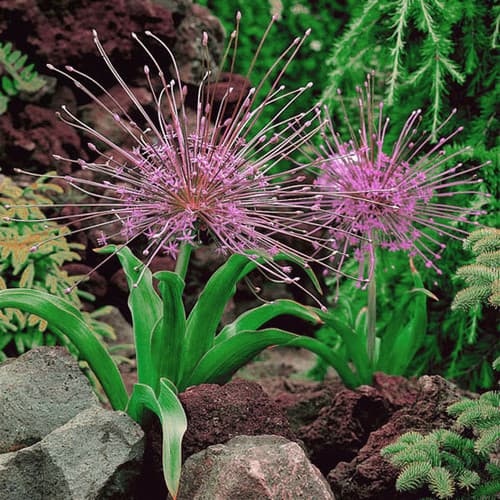
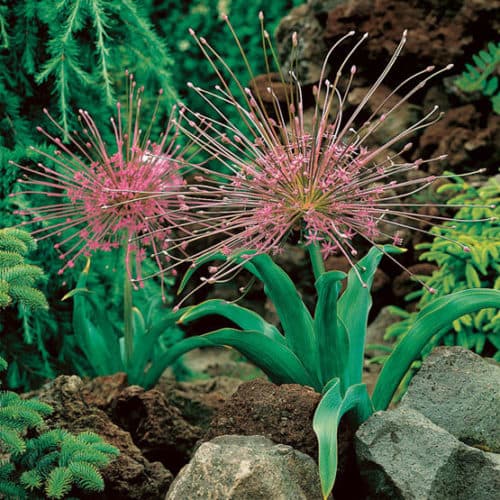
ABOUT
Allium schubertii, commonly known as Schubert's allium, is a striking and unusual plant that captures attention with its distinctive floral display. The most remarkable feature is its flower head, which consists of dozens of tiny flowers that create a large, spherical bloom. The individual flowers are borne on flower stalks of dramatically varying lengths, giving the bloom a unique, explosive appearance that can resemble a firework burst. The flowers themselves are typically a soft yet vibrant shade of pink or sometimes purplish, and they are star-shaped, which adds to the intricate beauty of the overall spherical form. The contrast between the long and short flower stalks in the inflorescence gives it a spiky, almost otherworldly aspect. At the base of this eye-catching floral display, the foliage of Schubert's allium is less showy. The leaves are typically a grayish-green color and strap-shaped, forming a clump at the base. The leaves are often overlooked as the spectacular bloom tends to overshadow them. Overall, Schubert's allium is treasured in gardens for its unique appearance that adds a dramatic touch to any floral composition or when it is planted in clusters. It is also a popular choice for cut flower arrangements due to the long-lasting nature of the blooms and their exceptional, attention-grabbing form.
About this plant
 Names
NamesFamily
Amaryllidaceae
Synonyms
Schubert's Allium, Tumbleweed Onion
Common names
Allium schubertii
 Toxicity
ToxicityTo humans
The plant in question, commonly known as Schubert's allium, is generally not considered toxic to humans. Most members of the Allium family, which includes onions, garlic, and chives, are not harmful if consumed in normal culinary quantities. However, excessive consumption can potentially lead to gastrointestinal discomfort or irritation. There are no severe toxic effects expected from ingesting parts of the Schubert's allium in moderate amounts.
To pets
Schubert's allium can be toxic to pets, especially cats and dogs. Members of the Allium family can cause gastrointestinal upset in pets, such as vomiting and diarrhea. More serious toxic effects include oxidative damage to red blood cells, which can lead to hemolytic anemia, a condition where red blood cells are destroyed faster than they can be made. Symptoms of poisoning in pets may include lethargy, abdominal pain, hypersalivation, and in severe cases, difficulty breathing or exercise intolerance. If a pet consumes Schubert's allium, it is advised to seek veterinary care promptly.
 Characteristics
CharacteristicsLife cycle
Perennials
Foliage type
Deciduous
Color of leaves
Green
Flower color
Pink
Height
1-2 feet (30-60 cm)
Spread
1-2 feet (30-60 cm)
Plant type
Bulb
Hardiness zones
5
Native area
Middle East
Benefits
 General Benefits
General Benefits- Aesthetic Appeal: Allium schubertii, also known as Schubert's allium, offers dramatic visual interest with its unique, spherical blooms that have a sparkler-like appearance, adding a distinctive look to any garden design.
- Attracts Pollinators: This ornamental onion attracts bees, butterflies, and other beneficial pollinators, which are essential for the health of your garden and the pollination of other plants.
- Low Maintenance: Schubert's allium is easy to grow and requires minimal care once established, making it an excellent choice for both novice and seasoned gardeners.
- Drought Tolerance: It is tolerant of drought conditions once it's established, reducing the need for frequent watering and making it suitable for xeriscaping.
- Deer and Rodent Resistant: Allium schubertii is not favored by deer or rodents, so it is less likely to be damaged by these animals than other garden plants.
- Long Bloom Time: The umbel-like blooms have an extended flowering period, which can last several weeks, providing a long-lasting display of color in the garden.
- Cut Flowers: The flowers of Schubert's allium are excellent for cutting and can be used in fresh or dried floral arrangements, adding beauty to your home as well as your garden.
- Architectural Structure: The tall stems and spherical flower structure of Allium schubertii add architectural interest to garden beds, borders, and containers.
- Late Spring to Early Summer Blooming: Its bloom time fills a seasonal gap in the garden between the spring bulbs and summer perennials, helping to ensure continuous color in the landscape.
- Container Gardening: Schubert's allium can be grown in pots or containers, providing flexibility in garden design and the ability to move the plants if necessary.
 Medical Properties
Medical PropertiesThis plant is not used for medical purposes.
 Air-purifying Qualities
Air-purifying QualitiesThis plant is not specifically known for air purifying qualities.
 Other Uses
Other Uses- Allium schubertii, also known as Schubert's allium, can be dried and used in flower arrangements, adding a dramatic and long-lasting element with its starburst-like blooms.
- The seed heads of Schubert's allium make for eye-catching additions to wreaths, bringing a unique texture and form to the design.
- You can spray paint the dried flowers of Schubert's allium to match the colors of your event or decor, as they hold paint well while maintaining their shape.
- Gardeners may use Schubert's allium as a natural marker for locations in their garden since their tall and distinctive shape makes them easy to spot.
- Artists and photographers often use Schubert's allium as subjects or backdrops for their works due to their visually striking appearance.
- The Schubert's allium can serve as an educational tool in horticulture classes for studying unique plant structures and reproductive strategies.
- These plants can be used in landscape design as focal points, drawing the eye to specific areas of the garden with their unusual flower form.
- Children can use the star-shaped seed heads of Schubert's allium for creative craft projects, like making natural fairytale wands or adding them to homemade mobiles.
- Biodegradable Schubert's allium seed heads can be used as packing material for shipping delicate items, adding a sustainable and decorative touch.
- The Schubert's allium can be part of a wildlife-friendly garden, attracting bees, butterflies, and other beneficial insects with its nectar-rich blooms.
Interesting Facts
 Feng Shui
Feng ShuiThe Schubertii Allium is not used in Feng Shui practice.
 Zodiac Sign Compitability
Zodiac Sign CompitabilityThe Schubertii Allium is not used in astrology practice.
 Plant Symbolism
Plant Symbolism- Uniqueness: With its dramatic explosion of tiny flowers, Schubert's allium (Allium schubertii) symbolizes uniqueness and eccentricity, highlighting individuality and the beauty of standing out.
- Strength and Resilience: As a member of the onion family, this allium's sturdy stem and long-lasting flowers represent strength and the ability to withstand challenging conditions.
- Prosperity and Abundance: The spherical shape, resembling a firework, signifies prosperity and abundance, mirroring a burst of wealth or success.
- Transformation: Its life cycle from a bulb to an impressive floral display can symbolize personal growth and transformation.
 Water
WaterSchubert's allium requires regular watering when the plant is actively growing and flowering, typically from spring to early summer. Water the plant deeply to ensure moisture reaches the roots, about 1 inch of water per week either from rainfall or manual watering. During the dormant period, after flowering has finished and the leaves have died back, reduce watering significantly to prevent bulb rot. It is important to water the plant in the morning to allow moisture on the foliage to dry before the cooler evening temperatures set in.
 Light
LightSchubert's allium thrives in full sunlight, so it's best to plant it in a location where it can receive at least six to eight hours of direct sun per day. The ideal spot is an open area that is not shaded by larger plants or structures. However, the bulbs can tolerate partial shade, especially in hotter climates where some afternoon shade can protect them from intense heat.
 Temperature
TemperatureSchubert's allium prefers temperate climates and can typically survive winter cold down to about -4 degrees Fahrenheit. The ideal growing temperatures for this ornamental onion are between 60 and 70 degrees Fahrenheit during the growing season. Extreme heat can be detrimental, so providing some shade during the hottest part of the day in warmer climates is beneficial.
 Pruning
PruningPruning is not necessary for Schubert's allium, as it naturally dies back after blooming. However, once the flowers have faded and the foliage has turned yellow and dried, you can cut back the stems to ground level to keep the garden tidy. This is typically done in late summer or early fall. Removing spent flowers can prevent self-seeding if you don't wish the plant to spread.
 Cleaning
CleaningAs needed
 Soil
SoilTumbleweed Onion (Allium schubertii) thrives in well-draining sandy or loamy soil with a pH ranging from 6.0 to 8.0. A good soil mix would be two parts loam, one part sand, and one part compost to enrich nutrients. Ensure the soil is rich and has good drainage to prevent bulb rot.
 Repotting
RepottingTumbleweed Onion bulbs do not need frequent repotting and should be repotted only when they outgrow their current space or every 3-4 years to refresh the soil. They are usually repotted in the fall after their foliage dies back or before new growth in spring.
 Humidity & Misting
Humidity & MistingTumbleweed Onion prefers normal outdoor humidity levels and does not require any special humidity requirements to thrive. They are adaptable to various conditions and too much humidity can lead to fungal problems.
 Suitable locations
Suitable locationsIndoor
Place Tumbleweed Onion in bright light, well-draining soil indoors.
Outdoor
Plant Tumbleweed Onion in full sun and well-draining soil.
Hardiness zone
5-8 USDA
 Life cycle
Life cycleAllium schubertii, known as Schubert's allium, begins its lifecycle as a bulb planted in the fall, lying dormant underground through the winter. In spring, the bulb germinates, sending up shoots that develop into long, strap-shaped leaves and a sturdy stem. By late spring or early summer, a large, spherical flower head composed of many small, star-shaped flowers emerges, creating a distinctive, explosive bloom display. After flowering, the plant sets seeds, which mature by late summer; these seeds may be dispersed by wind or wildlife, leading to germination and formation of new bulbs in subsequent seasons. The foliage of the plant withers away after seeding, and the bulb enters a period of dormancy, conserving energy to repeat the cycle in the following year. Regular yearly cycles of growth, reproduction, and dormancy occur as long as environmental conditions remain favorable.
 Propogation
PropogationPropogation time
Late Summer-Early Fall
Propogation: The most common method of propagation for the Allium schubertii, known as tumbleweed onion, is through division of bulbs. Usually, this is done when the plant is dormant, which typically happens in late summer to early fall. To propagate this way, carefully dig up the bulbs and gently separate the smaller bulblets from the parent bulb. Each bulblet is then replanted at a depth of around 3 inches (8 centimeters) in well-draining soil with the pointy end up. It is crucial to space the bulblets about 8 inches (20 centimeters) apart to allow for adequate space for the plants to mature. This method of division helps to ensure genetic consistency in the plants and can result in flowers in a couple of seasons as the bulblets grow to maturity.
